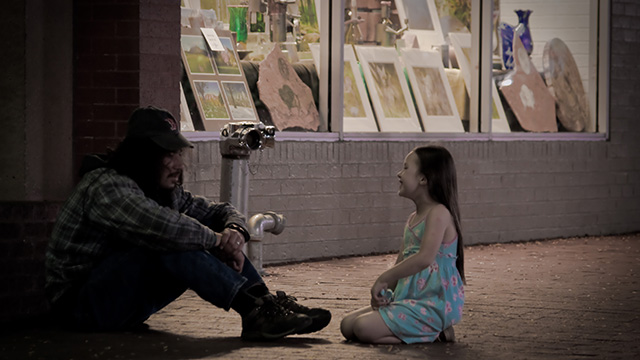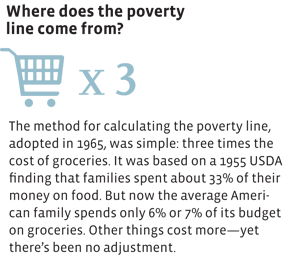This post first appeared at YES! Magazine.

Pearl Street, New York City. “This little girl and this man (I assume homeless) were talking, and they were laughing, smiling and loving every minute of it,” writes photographer Eric Magnuson. “The little girl couldn’t care less what the man looked like or what situation he was in. She just saw him as another person.” (Photo: Eric Magnuson/Flickr CC 2.0)
Inequality and poverty are suddenly hot topics, not only in the United States but also across the globe. Since the early 1980s, there has been a growing underclass in America. At the same time a much smaller class, now called the super-rich, built its wealth to levels of opulence not seen since France’s Louis XVI. Despite this, the resulting inequality went mostly unnoticed. When the Great Recession of 2008 hit, and the division between the very wealthy and the rest of us came starkly into focus, various people and groups, including the Occupy movement, began insisting more publicly that we tax wealth. But still, helping the poor has been mostly a discussion on the fringes. At last, the terms of public debate have changed, because inequality and poverty now are debated regularly in the mainstream media and across the political spectrum, not solely by labor, by the left and by others imagining a new economy.
Inserting such a controversial topic into mainstream discourse is French economist Thomas Piketty. His 700-page tome, Capital in the Twenty-First Century, shocked everyone this year when it made The New York Times bestseller list and bookstores found themselves backordering an economics book for legions of eager readers. Piketty did exhaustive searches of tax records from Great Britain, France and the United States, going as far back as the late 18th century in France. Using sophisticated computer modeling and analyses, the professor from the Paris School of Economics debunks a long-held assumption — that income from wages will tend to grow at roughly the same rate as wealth — and instead makes a compelling case that, over time, the apparatus of capitalism grows wealth faster than wages. Result: Inequality between the wealthy and everyone else will widen faster and faster; and, without progressive taxation, his data show we’ll return to levels of inequality not seen since America’s Gilded Age.
Piketty, no Marxist, says a solution lies in a “confiscatory” tax on wealth: Tax salaries over $500,000 at 80 percent worldwide, and tax wealth at 15 percent worldwide. Every year.
Unless we can reverse the inequality trends of the past 35 years, Piketty says, the ensuing social chaos will eventually destroy democracy. Unfortunately, not even Piketty sees much chance of all nations on Earth simultaneously enacting his tax plans.
But at least he sparked a widespread discussion. And fortunately, others have been digging deeply into the same questions, and they have some practical as well as achievable ideas for reversing poverty and inequality trends.
Investigation
Pulitizer Prize-winner Hedrick Smith authored a pageturner called Who Stole the American Dream? Despite his whodunnit title, Smith reveals the perps long before you finish the book. The former New York Times reporter uses data and real-life stories to build a case against American CEOs and the politicians who do their bidding.
Between 1945 and 1973, Smith notes, US workers’ productivity grew by 96 percent, and they were rewarded with a 94 percent increase in their wages. Between 1973 and 2011, years that parallel a collapse of the middle class, US workers’ productivity grew by 80 percent, yet those evermore-productive employees saw only a 10 percent increase in their wages. Millions who created that wealth were thus pushed into poverty or to its precipice, while those who fancy a neomedieval economic system transferred billions in profits, generated by that labor, upward to themselves.
Gar Alperovitz is a professor of political economy at the University of Maryland. Like Smith, Alperovitz asks a question with his book’s title: What Then Must We Do? To be more accurate, he might have called it “Here’s What We’re Already Doing” — to create fresh models that can inspire a new economy.
What makes Alperovitz’s ideas valuable is that he not only lays out an array of alternatives already keeping people from poverty, but solutions we also can build upon to create strategies that, over time, might replace corporate capitalism.
 And replacing capitalism no longer is farfetched. In 2013, Alperovitz was invited to address the Academy of Management, a group mostly of corporate advisers and business school professors with 20,000 members worldwide, “and the entire focus of the meeting was: Is capitalism over? — and, if so, where are we going?” Alperovitz pointed out during an extended conversation: “Even these people are now open to new ideas.”
And replacing capitalism no longer is farfetched. In 2013, Alperovitz was invited to address the Academy of Management, a group mostly of corporate advisers and business school professors with 20,000 members worldwide, “and the entire focus of the meeting was: Is capitalism over? — and, if so, where are we going?” Alperovitz pointed out during an extended conversation: “Even these people are now open to new ideas.”
Smith makes a similar point. The American system is now so obviously broken that even some corporate leaders are calling for a “domestic Marshall Plan” to repair our economy. From their thinking and others, he puts forward a proposal to reclaim the American Dream.
Start, he says, by creating a public-private partnership to generate 5 million new jobs rebuilding infrastructure — bridges, highways and rail corridors. Increase government investment in science and high-technology research to bolster US innovation and spur a manufacturing renaissance.
Make income tax fairer, which will decrease inequality, then fix the corporate tax structure so it promotes American jobs and curtails outsourcing. At the same time, force China to live up to ethical trading principles because that would generate up to 4 million US jobs.
We can cut the Pentagon budget by $1 trillion — not much more than 10 percent of annual military spending — over the next decade, Smith says, and pump the money into this domestic Marshall Plan. We should also refinance millions of homes now “underwater” and strengthen safety-net programs such as Social Security and Medicare.
The bad news: Much of this new Marshall Plan depends on congressional action, where such ideas have little chance as long as the current gridlock prevails.
“Changing America’s direction will not be easy,” Smith says. “It will happen only if there is a populist, grassroots surge demanding it, like the mass movements of the 1960s and 1970s.”
Our political system is as broken as our economic system. But Americans could mobilize to reform electoral politics and reduce the influence of money in elections. And for those who are disenchanted with government, Smith recommends that they take a look at how well it’s working for the mobilized and active financial superclass.
In the meantime

While we’re working on mobilizing to take back our democracy, we can start from the bottom up to “democratize wealth,” as both Piketty and Alperovitz say we must. Alperovitz puts less faith in top-down institutions than does Smith (the subtitle of What Then Shall We Do? is Straight Talk About the Next American Revolution). He lays out bottom-up solutions already in practice across America that offer superior alternatives to the status quo. Here’s a sampling:
Worker ownership.
It’s not just little startups and co-ops. Alperovitz points to the company ranked 48th on the Forbes list of the largest US private companies: Hy-Vee, a Midwestern supermarket chain that currently has more than 69,000 employees and more than $8 billion in sales, is owned by employees through a profit-sharing program. W.L. Gore & Associates, makers of Gore-Tex, has been owned since 1974 by its workers — currently more than 10,000 in 30 countries generating annual revenues of about $3 billion.
Already, some 11,000 companies employing 10.3 million people operate under such employee stock-ownership plans, with more forming regularly.
Social enterprises.
Pioneer Human Services, in Seattle, is a textbook example of this model, a form of democratized ownership that uses the money it earns as well as the enterprises it creates to achieve broader social purposes. According to Alperovitz, a large portion of Pioneer’s $67 million annual budget comes from businesses it created. The organization produces thousands of machined parts for Boeing, caters more then 1,500 meals a day for hospitals and other facilities, and employs almost 1,000 people usually classified as impaired or unemployable. Pioneer is but one of many such social enterprises doing good and democratizing wealth.
Traditional co-ops.
Alperovitz says that more than 130 million Americans — more than 40 percent of the population — belong to one or more co-ops. Not just food co-ops but also agricultural co-ops, electric co-ops, insurance co-ops, retail co-ops (such as REI) and retailer-owned co-ops (such as ACE Hardware), healthcare co-ops, high-technology industry co-ops, artist co-ops and credit unions. The Alliance to Develop Power, in Western Massachusetts, has developed what Alperovitz calls an $80 million “community economy” of housing co-ops and other cooperatively controlled businesses.
Community development corporations.
Almost 5,000 such organizations now operate in larger US cities. These primarily incubate small businesses and develop low-income housing. In Newark, Alperovitz says, the New Community Corporation employs about 600 neighborhood residents, manages 2,000 housing units and has built up $500 million in assets. Profits from its businesses, which include a shopping center, help support day-care and afterschool programs and a nursing home.
Land trusts.
Hundreds of these exist today, both urban and rural. By taking land out of the speculative market and democratizing ownership, such nonprofits prevent gentrification and support low – and moderate – income housing with development profits. By 2012, Alperovitz says, 255 land trusts were operating in 45 states and the District of Columbia.
Government-owned and operated businesses.
Today, more than 50 percent of cities larger than 100,000 are making municipal equity investments in local business. Now is the time, Alperovitz says, to expand these investments to co-ops, employee-owned businesses, social enterprises and nonprofit land development. “If you’re going to get serious about systemic change — not just ‘projects’ — you’re ultimately going to have to consider what government does,” he says, “and how it can be used to further the vision and the model you affirm.”
Already forms of this are happening from Cleveland to San Diego. One of the first was Boston, which in 1976 renovated historic Fanueil Hall, transforming it into Faneuil Hall Marketplace, a downtown retail center with 49 shops, 18 restaurants and pubs and 44 pushcarts. Instead of turning things over to its joint-venture partner, Rouse Company, the city kept the property under municipal ownership and took profits in lieu of property taxes from Rouse. The strategy earned the city 40 percent more revenue than it would have collected in taxes.
Another example: More and more cities are building — and owning — hotels and using the profits to shore up their emaciated budgets. Dallas, Texas, not known for left-wing collectivism, opened the city-owned $500 million, 23-story, 1001-room Omni Dallas Hotel in 2011.
Transform too-big-to-fail-banks.
and other private corporations that teeter on insolvency, into public utilities. The next time Bank of America’s risky scams threaten to implode the world’s economy, Alperovitz says we should bail out the bank — and assume public ownership of the corporation. If that idea seems radical, it arose from the militantly conservative economists of the Chicago School of Economics during the Great Depression.
“Every industry should be either effectively competitive or socialized,” wrote Harry C. Simon, one of the school’s revered thinkers. Simon and seven of his conservative colleagues proposed a “Chicago Plan” that called for public ownership of Federal Reserve Banks, nationalizing the creation of money and turning private banks into highly restricted savings-and-loan associations.
Or, in Alperovitz’s 21st century version, “Take them over; turn them into public utilities.”
Need for strategy
At the moment corporations “certainly have the power. But I’m a historian; I think in decades,” he says, “not months. Power comes and goes. It could take 20, even 50 years,” adding that in the face of so much money and corporate power “it might not be possible to change the system.”
“Or,” he adds, after a perfectly timed pause, “as in the case of ending apartheid; as in the case of the American Revolution; as in the case of the French Revolution; as in the case of the women’s revolution; as in the case of the fall of communism — building from the bottom up, over time, is actually how you transform systems.”
The views expressed in this post are the author’s alone, and presented here to offer a variety of perspectives to our readers.


